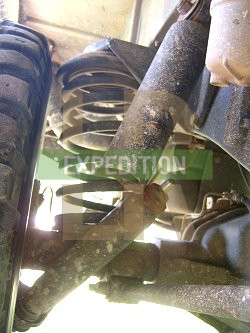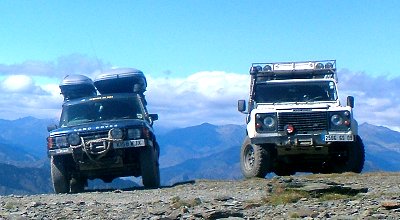5 Desirable Land Rover Expedition Modifications
I've already talked about the essential modifications to your Land Rover for going on expedition, so i'm going to list a few things that I see as the next step up in the process of modification. In the future I will be discussing modifications that are more optional and advanced, but for the moment, these 5 are what I deem as desirable modifications for your expedition Land Rover.
Roll cage
Just like all safety devices and insurance, it only pays for itself if it's ever needed, which you never have the foresight for. However, when it comes to roll cages for Land Rovers I think it's a sound investment. Land Rovers have a high centre of gravity and even moreso having a roof laden with supplies and a tent. The alumnium bodywork is very soft and Defenders have been described as "all being soft tops".
I have personal experience of the saving grace of roll cages during a freak accident in Belize. In that instance, the Safety Devices cage had paid for itself. The choices for fitting a roll cage come down to external and internal cages, full or half body.
 An internal cage keeps the vehicle looking more standard from the outside, but reduces the load capacity especially in the back. An external cage keeps the original load capacity and has the added benefit of protecting the bodywork and allowing a stronger contact point for a roof rack, but increases wind resistance. Roll cages can be expensive and that's where the full or half body choice comes in. A roll cage over the cab area is a must - these are usually external anyway - but extending over the rear will protect the larger part of the vehicle and all that it carries. Roll cages come in varying guises and designs, but it is important to make sure that the design goes through bodywork and bolts directly to the chassis.
An internal cage keeps the vehicle looking more standard from the outside, but reduces the load capacity especially in the back. An external cage keeps the original load capacity and has the added benefit of protecting the bodywork and allowing a stronger contact point for a roof rack, but increases wind resistance. Roll cages can be expensive and that's where the full or half body choice comes in. A roll cage over the cab area is a must - these are usually external anyway - but extending over the rear will protect the larger part of the vehicle and all that it carries. Roll cages come in varying guises and designs, but it is important to make sure that the design goes through bodywork and bolts directly to the chassis.
Disc Handbrake
A disc handbrake does away with a gunked up brake drum off road and has the advantage of using discs over drums. As far as I know there is only one manufacturer that produces one and that is X-Eng (now through Foundry 4x4, so they have a bit of a monopoly on the market and therefore charge over £200 for what is really a wheel disc adapted for cable operation).
The standard handbrake in a Land Rover is rather the weak link in the scope of the design. It acts on the transmission rather than the brake pads, so cannot prevent roll back on hills. The assembly itself is a large drum that rotates at the back of the transfer box, so in muddier terrain has the habit of collecting mud and debris which is detrimental to the brake efficiency.
Whilst it is normally safe to put the Land Rover in gear when parked anyway, being in an offroad situation and having to rely on the handbrake can be crucial to safety and success on the terrain. Imagine climbing a steep muddy hill, the handbrake drum all gunked up and trying to do a hill start past a tricky section. I've been on such long slippery hills that took me such effort just to traverse the first 10 metres, I would rather stick where I am on the handbrake and try again rather than reversing all the way to the bottom for another shot. I found the standard brake to be holy ineffective and warranted a lot of hasty footwork.
Heavy duty suspension
The toll of driving for extended periods offroad is taken mostly by the suspension. Improving the suspension can take on a variety of guises from replacing shock absorbers, increasing travel, removing roll bars, adding a lift kit, adding heavier springs or dislocation cones.
 I've had a number of shock absorber trumpets shear off, so would place emphasis on getting a toughened turret. When doing this I would also consider a dual shock turret, for sharing the stress. A decent set of shock absorbers would be beneficial over and above the standard £10 variety. A broken shock absorber allows the spring to come free and could end up wearing through your tire. Dislocation cones for this instance would be handy.
I've had a number of shock absorber trumpets shear off, so would place emphasis on getting a toughened turret. When doing this I would also consider a dual shock turret, for sharing the stress. A decent set of shock absorbers would be beneficial over and above the standard £10 variety. A broken shock absorber allows the spring to come free and could end up wearing through your tire. Dislocation cones for this instance would be handy.
A lift kit raises the centre of gravity and means your Universal Joints wear through quicker due to the increased angle the propshafts work at. However, it can make a difference when driving in muddy ruts to prevent the vehicle being grounded or coming to a halt when the gearbox crossmember scoops all the mud up into your chassis.
Longer springs have the same effect as a lift kit whilst increasing the axle articulation (providing you have the longer shocks too). Changing the springs to those with a higher load rating has a great comfort benefit if you're expecting to be carrying a lot on your expedition. It reduces the amount you bottom out and the amount of lolloping around for smaller bumps. Paddocks have a variety of heavy duty suspension parts.
Polybushes
Along with the suspension components are the little rubber things that hold it all together. In harse climates, the rubber of standard bushes can perish surprisingly quickly, and the extra usage of the suspension adds to this. Once a bush goes it has a lasting effect on your suspension ride, so it needs to be replaced. Polybushes are an all round tougher material, sometimes brightly coloured, but a great addition to prevent having to carry a plethora of extra bushes and frequently changing them. They're not the best thing for every situation so make sure you understand the pros and cons.
Long range fuel tank
A larger fuel tank can be especially useful on desert expeditions, many miles between towns. The range on a standard Land Rover 110 fuel tank is pretty good at around 6-700km but an additional tank can push that further. Carrying extra fuel can give the benefit of stocking up in one country where fuel is cheaper, like Egypt (back when it was safe), before progressing over a border where it might be more expensive. The alternative is using jerry cans, but these take up space that could be used for other things and have the chance of being stolen too. Safari Equipment have a good variety of additional fuel tanks.
Main photo courtesy of Land Treks.
